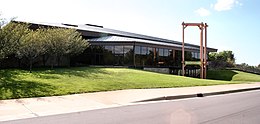
Connersville is a city in Fayette County, Indiana, United States, 66 miles (106 km) east by southeast of Indianapolis. The population was 13,324 at the 2020 census. The city is the county seat of and the largest and only incorporated town in Fayette County. The city is in the center of a large rural area of east central Indiana; the nearest significant city is Richmond, 26 miles (42 km) to the northeast by road. Connersville is home to the county's only high school. The local economy relies on manufacturing, retail, and healthcare to sustain itself. However, there has been a consistent decline in both employment and population since the 1960s, placing it among the least affluent areas in the state, as indicated by measures such as median household income and other economic indicators.

Fishers is a city in Fall Creek and Delaware townships in Hamilton County, Indiana, United States. As of the 2020 census the population was 98,677. A suburb of Indianapolis, Fishers has grown rapidly in recent decades: about 350 people lived there in 1963, 2,000 in 1980, and only 7,500 as recently as 1990.

Noblesville is a city in and the county seat of Hamilton County, Indiana, United States, a part of the north Indianapolis suburbs along the White River. The population was 69,604 at the 2020 census, making it the state's 10th most populous city, up from 14th in 2010. The city is part of Delaware, Fall Creek, Noblesville, and Wayne townships.
Douglas C. Bennett is a former president of Earlham College, located in Richmond, Indiana. He was installed as president in 1996. Beginning in 1997, Bennett was also a member of the politics department at Earlham.

Eli Lilly was a Union Army officer, pharmacist, chemist, and businessman who founded Eli Lilly and Company.
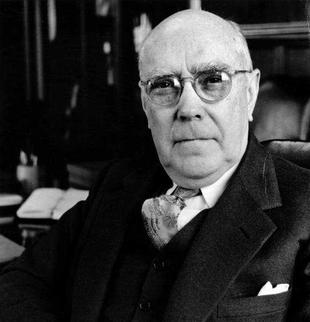
Eli Lilly, sometimes referred to as Eli Lilly Jr. to distinguish him from his grandfather of the same name, was an American pharmaceutical industrialist and philanthropist from Indianapolis, Indiana. During his tenure as head of Eli Lilly and Company, which was founded by his grandfather, the company grew from a successful, family-owned business into a modern corporation and industry leader. Lilly served as the company president (1932–1948), chairman of the board of directors, and honorary chairman of the board.
Lilly Endowment Inc., headquartered in Indianapolis, Indiana, is one of the world's largest private philanthropic foundations and among the largest endowments in the United States. It was founded in 1937 by Josiah K. Lilly Sr. and his sons, Eli Jr. and Josiah Jr. (Joe), with an initial gift of Eli Lilly and Company stock valued at $280,000 USD. As of 2020, its total assets were worth $21 billion.

The Children's Museum of Indianapolis is the world's largest children's museum. It is located at 3000 North Meridian Street, Indianapolis, Indiana in the United Northwest Area neighborhood of the city. The museum is accredited by the American Alliance of Museums. It is 472,900 square feet (43,933.85 m2) with five floors of exhibit halls, and receives more than one million visitors annually. Its collection of over 130,000 artifacts and exhibit items is divided into two domains: Arts & Humanities and the Natural Sciences. Among the exhibits are simulated Cretaceous and Jurassic dinosaur habitats, a carousel, a steam locomotive, and the glass sculpture Fireworks of Glass Tower and Ceiling. The museum's focus is family learning; most exhibits are designed to be interactive.
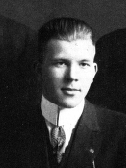
Josiah Kirby "Joe" Lilly Jr. was a businessman and industrialist who served as president and chairman of the board (1953–66) of Eli Lilly and Company, the pharmaceutical firm his grandfather, Colonel Eli Lilly, founded in Indianapolis in 1876. Lilly, the younger son and namesake of Josiah K. Lilly Sr., graduated from the University of Michigan's School of Pharmacy in 1914 where he was a member of the Chi Psi Fraternity. He served in the United States Army in France during World War I.

Glenn Albert Black was an American archaeologist, author, and part-time university lecturer who was among the first professional archaeologists to study prehistoric sites in Indiana continuously. Black, a pioneer and innovator in developing archaeology field research techniques, is best known for his excavation of Angel Mounds, a Mississippian community near present-day Evansville, Indiana, that he brought to national attention. Angel Mounds was designated a National Historic Landmark in 1964. Black was largely self-taught and began serious work on archaeological sites in Indiana in the 1930s, before there were many training opportunities in archaeology in the United States. He is considered to have been the first full-time professional archaeologist focusing on Indiana's ancient history, and the only professional archaeologist in the state until the 1960s. During his thirty-five-year career as an archaeologist in Indiana, Black also worked as a part-time lecturer at Indiana University Bloomington from 1944 to 1960 and conducted a field school at the Angel site during the summer months.

The Indiana State Museum is a museum located in downtown Indianapolis, Indiana, United States. The museum houses exhibits on the science, art, culture, and history of Indiana from prehistoric times to the present day.

The Morris–Butler House is a Second Empire-style house built about 1864 in the Old Northside Historic District of Indianapolis, Indiana. Restored as a museum home by Indiana Landmarks between 1964 and 1969, the American Civil War-era residence was the non-profit organization's first preservation project. Restoration work retained some of its original architectural features, and the home was furnished in Victorian and Post-Victorian styles. Its use was changed to a venue for Indiana Landmarks programs, special events, and private rentals following a refurbishment in 2013. Regular daily tours of the property have been discontinued.

William Conner was an American trader, interpreter, military scout, community leader, entrepreneur, and politician. Although Conner initially established himself as a fur trader on the Michigan and Indiana frontiers, his business interests later expanded to include ownership of Indiana farms, mills, distilleries, and mercantile shops. He was also a land speculator. Conner served the American forces in several capacities during the War of 1812, and as an interpreter and witness at several treaty negotiations with Native American tribes that resulted in their removal from Indiana and established the state's geographical boundaries.
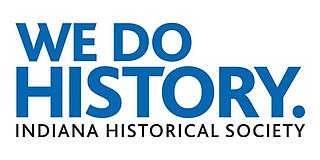
The Indiana Historical Society (IHS) is one of the United States' oldest and largest historical societies. It describes itself as "Indiana's Storyteller".
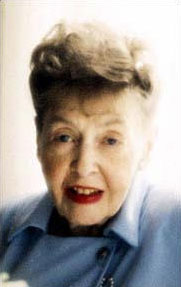
Ruth Lilly was an American philanthropist, the last surviving great-grandchild of Eli Lilly, founder of the Eli Lilly and Company pharmaceutical firm, and heir to the Lilly family fortune. A lifelong resident of Indianapolis, Indiana, Ruth Lilly is estimated to have given away nearly $800 million of her inheritance during her lifetime, mostly in support of the arts, education, health, and environmental causes in Indianapolis and in Indiana.

Oldfields, also known as Lilly House and Gardens, is a 26-acre (11 ha) historic estate and house museum at Newfields in Indianapolis, Indiana, United States. The estate, an example of the American country house movement of the late nineteenth and early twentieth centuries, was designated a U.S. National Historic Landmark in 2003.

Indiana, a state in the Midwest, played an important role in supporting the Union during the American Civil War. Despite anti-war activity within the state, and southern Indiana's ancestral ties to the South, Indiana was a strong supporter of the Union. Indiana contributed approximately 210,000 Union soldiers, sailors, and marines. Indiana's soldiers served in 308 military engagements during the war; the majority of them in the western theater, between the Mississippi River and the Appalachian Mountains. Indiana's war-related deaths reached 25,028. Its state government provided funds to purchase equipment, food, and supplies for troops in the field. Indiana, an agriculturally rich state containing the fifth-highest population in the Union, was critical to the North's success due to its geographical location, large population, and agricultural production. Indiana residents, also known as Hoosiers, supplied the Union with manpower for the war effort, a railroad network and access to the Ohio River and the Great Lakes, and agricultural products such as grain and livestock. The state experienced two minor raids by Confederate forces, and one major raid in 1863, which caused a brief panic in southern portions of the state and its capital city, Indianapolis.
Mekinges Conner was a Lenape woman.
Ruth Allison Lilly (1891–1973) was an art collector and philanthropist from Indianapolis, Indiana. Married to industrialist and philanthropist Eli Lilly for 45 years, she is noted for her many contributions to the arts and culture landscape of Indiana, particularly Indianapolis.






